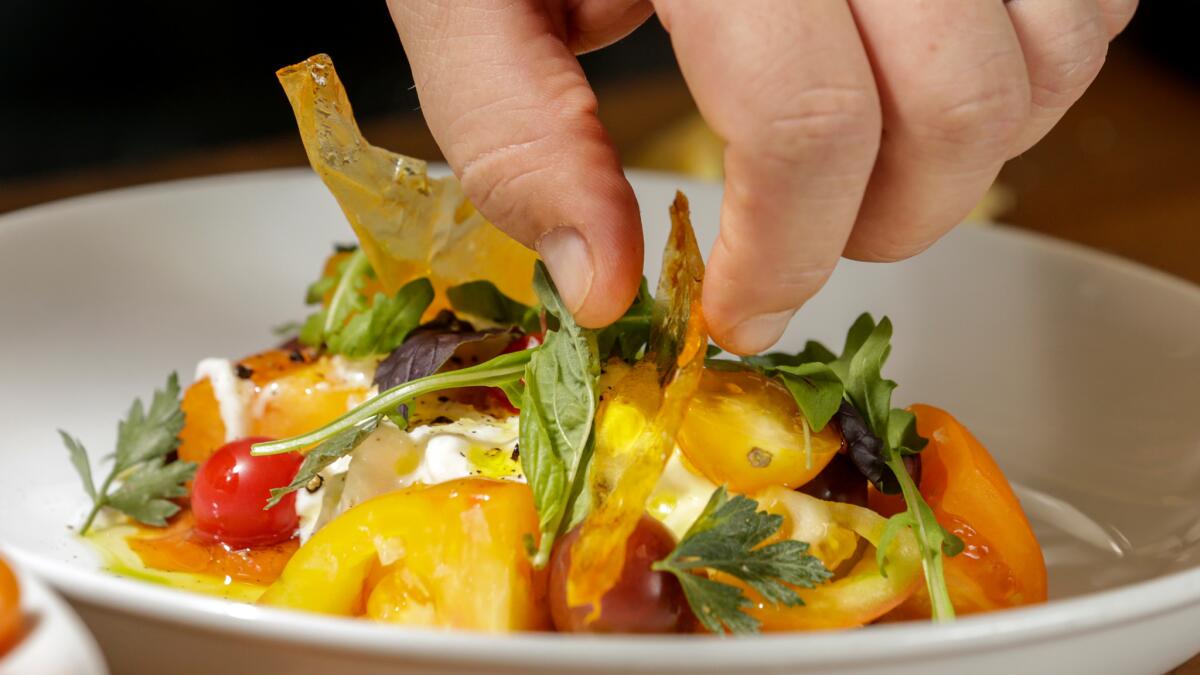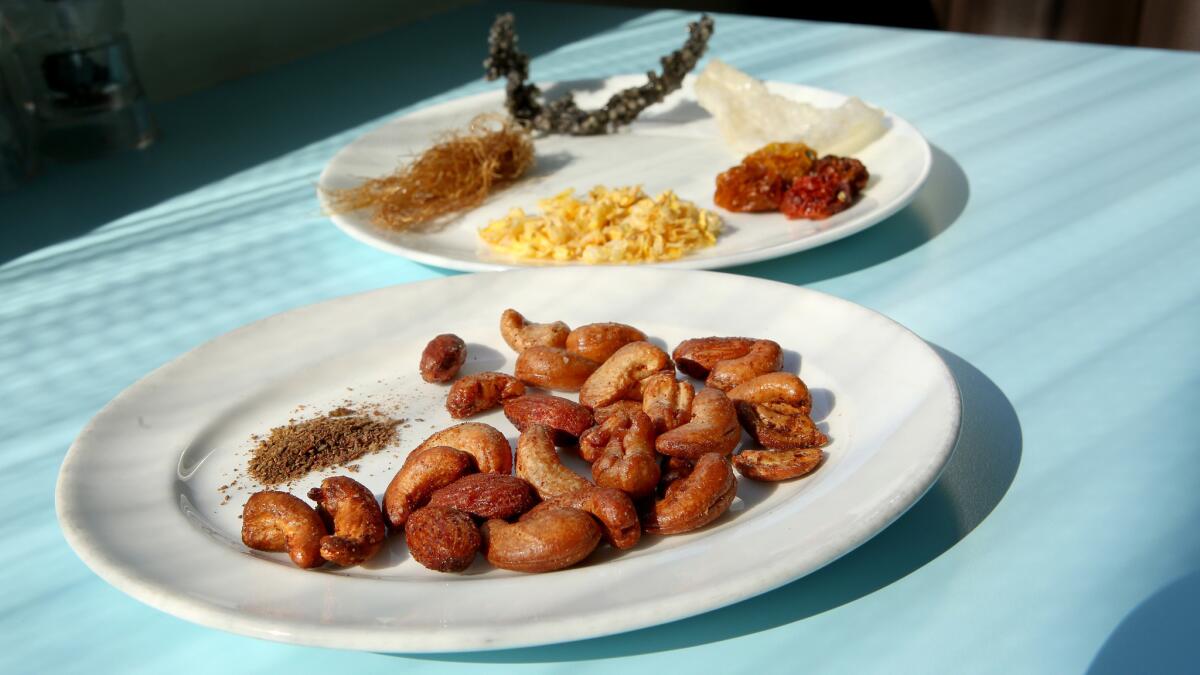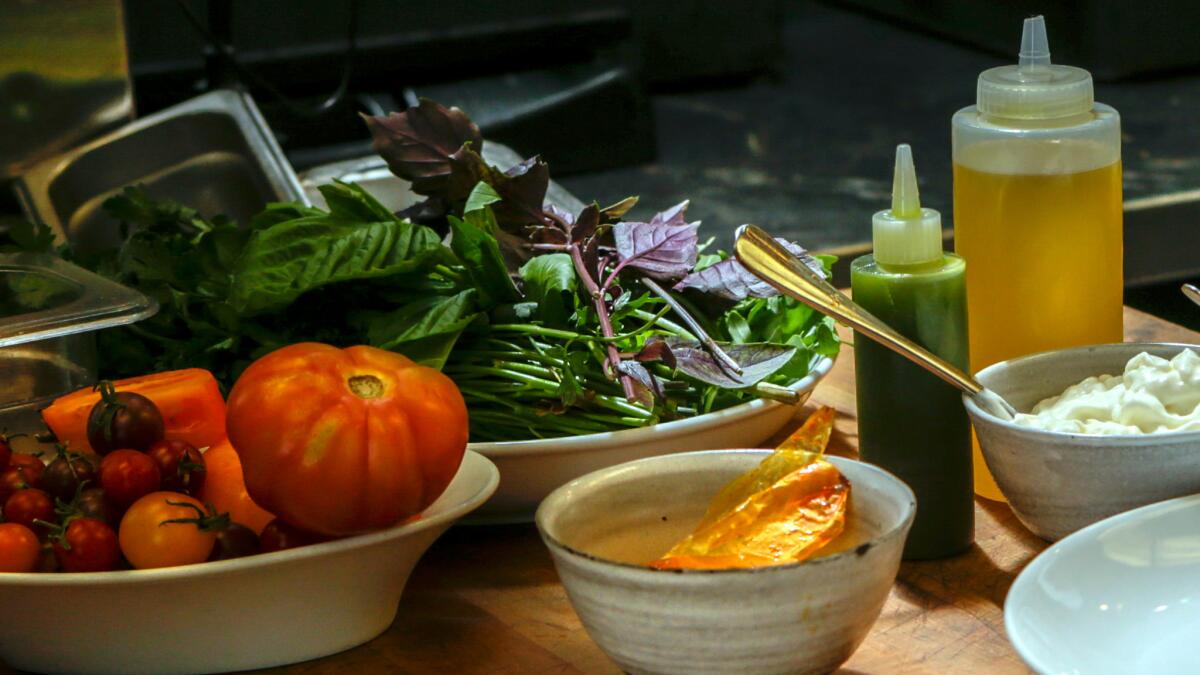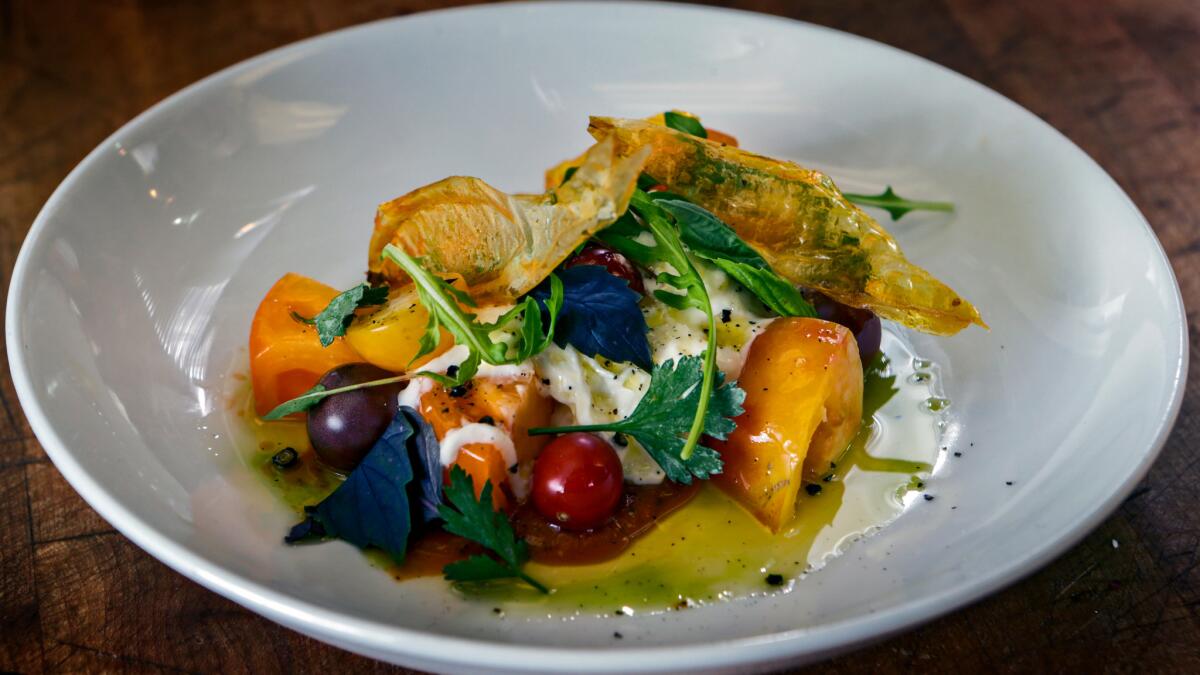Why chefs love dehydrators, plus some recipes you might actually try

- Share via
Kitchen gadget fads come and go, but every now and then an appliance outlives a trend. The Robot Coupe, an industrial food processor with a tireless engine, and the Vitamix, the Ferrari of blenders, are as commonplace as pots and pans in restaurant kitchens today. And now, at least in Los Angeles, an unlikely addition vies for their counter space — the decidedly unsexy dehydrator.
At restaurants all over town, black plastic boxes the size of countertop toaster ovens quietly purr from the dark corners of dry storage. At their most basic, these machines employ a lamp and a fan to circulate dry air at temperatures that range from 95 to 155 degrees. The slow, steady airflow preserves fruit, vegetables, meat and seafood by evaporating moisture and thereby removing the potential for spoilage.
For the record:
9:17 p.m. Jan. 22, 2025This article misspells raw-food movement pioneer Ann Wigmore’s last name as Wigman.
By design, the dehydrator pulls long hours — apricot slabs need 24 hours at 135 degrees to shrink into fruit leather, and tomatoes require a full eight-hour work day to shed their moisture, but compared with solar drying, which can take days even in sunny climates with low humidity, the modern-day dehydrator is to sun-drying what the blender is to a mortar and pestle - easy and efficient.

Recipe: Bar nuts with dehydrated kimchi »
YouTube will tell you how to MacGyver your own for under $20 using a cardboard box, a heat lamp, duct tape and aluminum foil, but for a hundred dollars or so more you can take home an Excalibur, the workhorse of choice, which offers amenities like an adjustable thermostat and an on/off switch.
It was over 40 years ago when Air Force engineer Roger Orton constructed the first Excalibur in his Sacramento garage. The invention came on the heels of his grain-grinder kit, a DIY appliance that sold 10,000 units and introduced him to a clientele of rugged individualists. At the suggestion of a friend, he began tinkering with existing dehydrators and created the first controlled-temperature environment for drying food.
The early models were a hit with Depression-era home cooks who saw it as a way to save money and store food, as well as baby boomers who wanted to make fruit leather for backpacking trips. Over time organic gardeners caught on, as did hunters and preppers who used it to make their own jerky. Orton won over Ann Wigman, an early pioneer in the raw-food movement, who went on to champion his device, and even sold it to dental offices, which use it to dry those plaster of Paris molds of your teeth. But in the hands of chefs, Orton’s dehydrator morphs into a creative tool that can add flavor, manipulate texture and best of all, eliminate food waste.

At Alma, chef Ari Taymor’s restaurant inside the Standard hotel in West Hollywood, the Excalibur is always buzzing. On a recent visit, the dehydrator was busy sucking the moisture from Taymor’s house-made kimchi, which would later be ground to a powder and used to season the restaurant’s bar nuts. Sprinkled over popcorn or used to season scrambled eggs, one can imagine the same kimchi powder becoming a habit-forming pantry staple.
Elsewhere in the kitchen, dehydrated fruits and vegetables become mise-en-place for dinner service. Dried apricots will soon be reconstituted in chicken broth to form sweet and savory gummies, and dehydrated corn silk will be deep fried and fashioned into an edible birds nest — a quaint presentation that delivers a salty satisfying crunch.
Beyond the culinary usefulness of building a pantry, the dehydrator has wooed chefs across the city as a tool for reducing waste. On a recent afternoon at Rustic Canyon in Santa Monica, chef Jeremy Fox showed off a mesh tray lined with gnarly clumps of dried beet pulp, the fibrous leftovers from juicing. “I feel wrong if I throw anything away,” he said while examining the pulp, which is part of the base for the edible soil in his signature beets and berries salad.

Recipe: Caprese salad with heirloom tomato skin chips »
For Fox, the dehydrator is a solution to a problem, a way to stop time on product that might otherwise go bad. “Having it be delicious isn’t necessarily the point,” he says of the desiccated vegetable matter. It’s utilizing the product that matters.
For instance, he continues, “If I make this carrot powder out of scraps or peels and put it into something, has it necessarily elevated the dish? I’m not so worried about elevating it. I don’t want to make it worse, but I’m using it when I could have just thrown it away and called it a day.”
So the solids from straining Rustic Canyon’s posole sauce — a mix of raw poblano and jalapeño peppers, garlic, cilantro, olive oil, vinegar and salt — are dehydrated, ground to a powder and used to season the steak. The resulting green powder tastes “like salsa verde Doritos,” Fox says, and is craveable in its own right.
Similarly, chef Bruce Kalman of Union in Pasadena utilizes the dehydrator to rescue roasted tomato skins that would otherwise end up in the compost bin. Long a proponent of root-to-leaf cooking, even cherry tomato stems at Union are salvaged and dehydrated for an earthy tomato salt.
For Kalman, making roasted tomato chips doesn’t just curb waste, it improves what would otherwise be a simple caprese salad. “If I want to do a dish with tomatoes,” he says, “then I want it to taste like in-your-face tomatoes.” And the dehydrator, which concentrates flavor, will achieve that.
Unlike luxury appliances like Anti-Griddles and Rotovaps, the humble dehydrator feels like less of a toy than a necessity. Forty percent of the food produced in the United States is wasted, so if a plastic box with a lightbulb and a fan can spark creativity and enhance flavor while preventing some of that product from ending up in the waste bin, then every kitchen should have one.
More to Read
Eat your way across L.A.
Get our weekly Tasting Notes newsletter for reviews, news and more.
You may occasionally receive promotional content from the Los Angeles Times.









